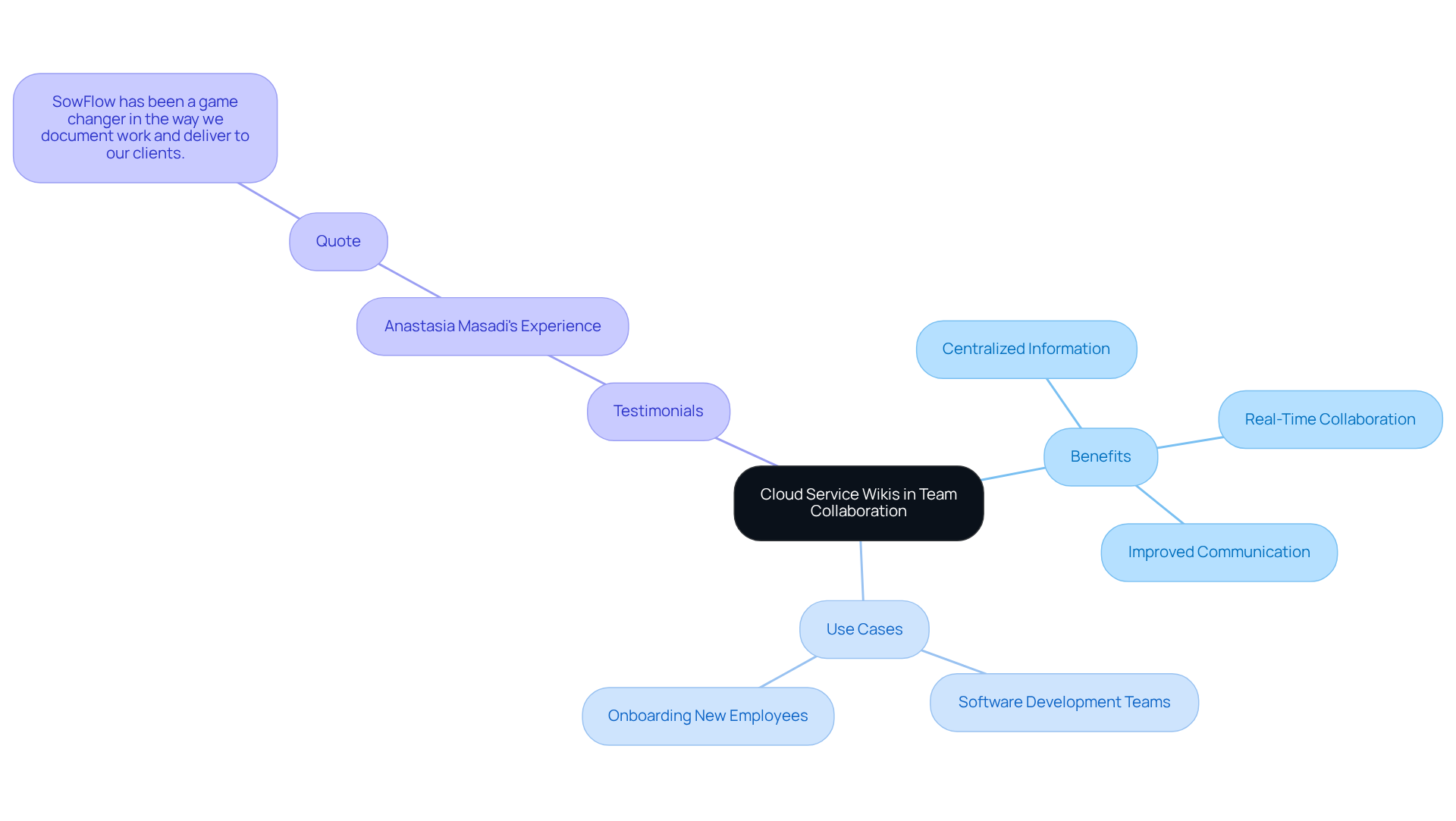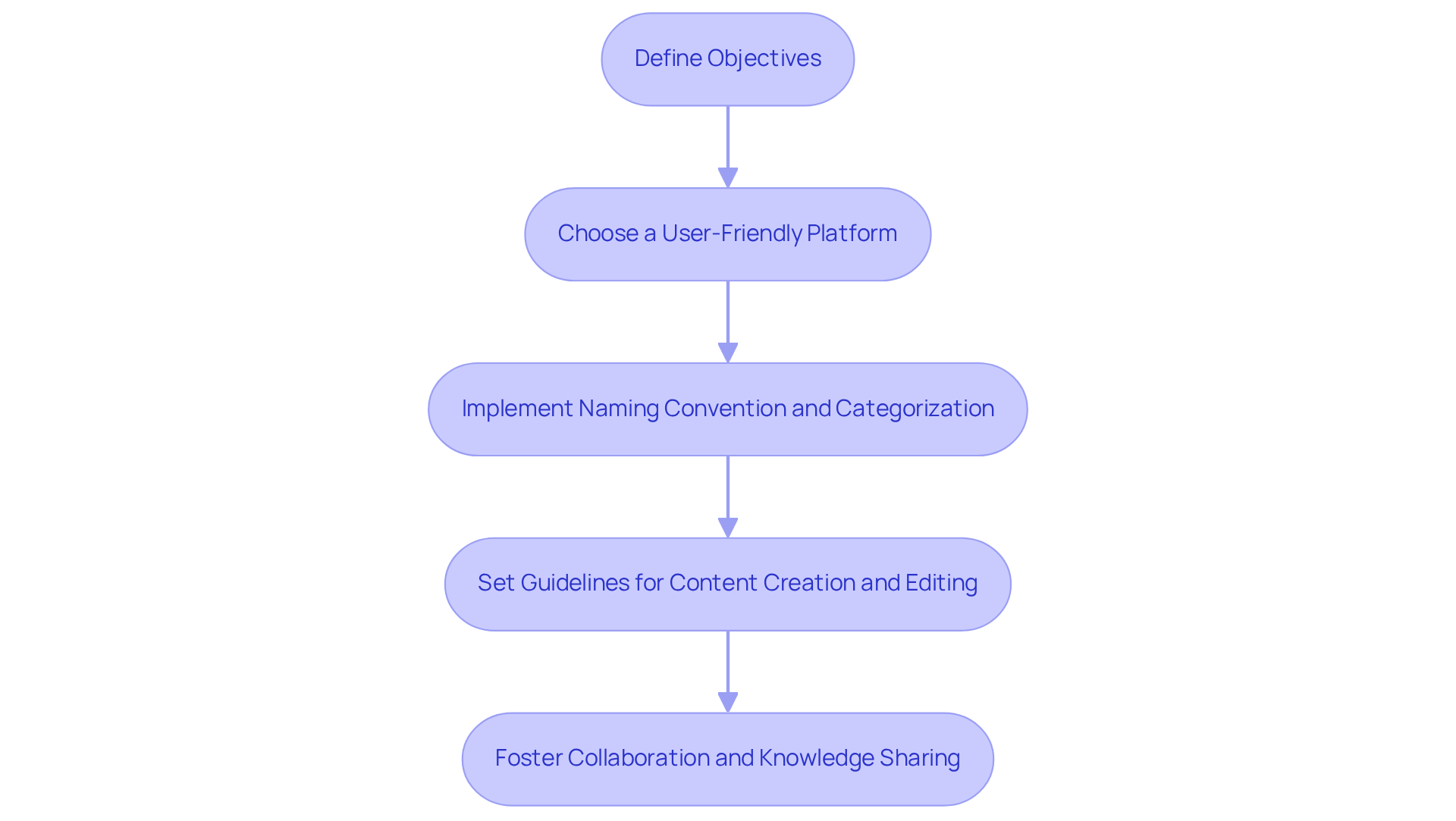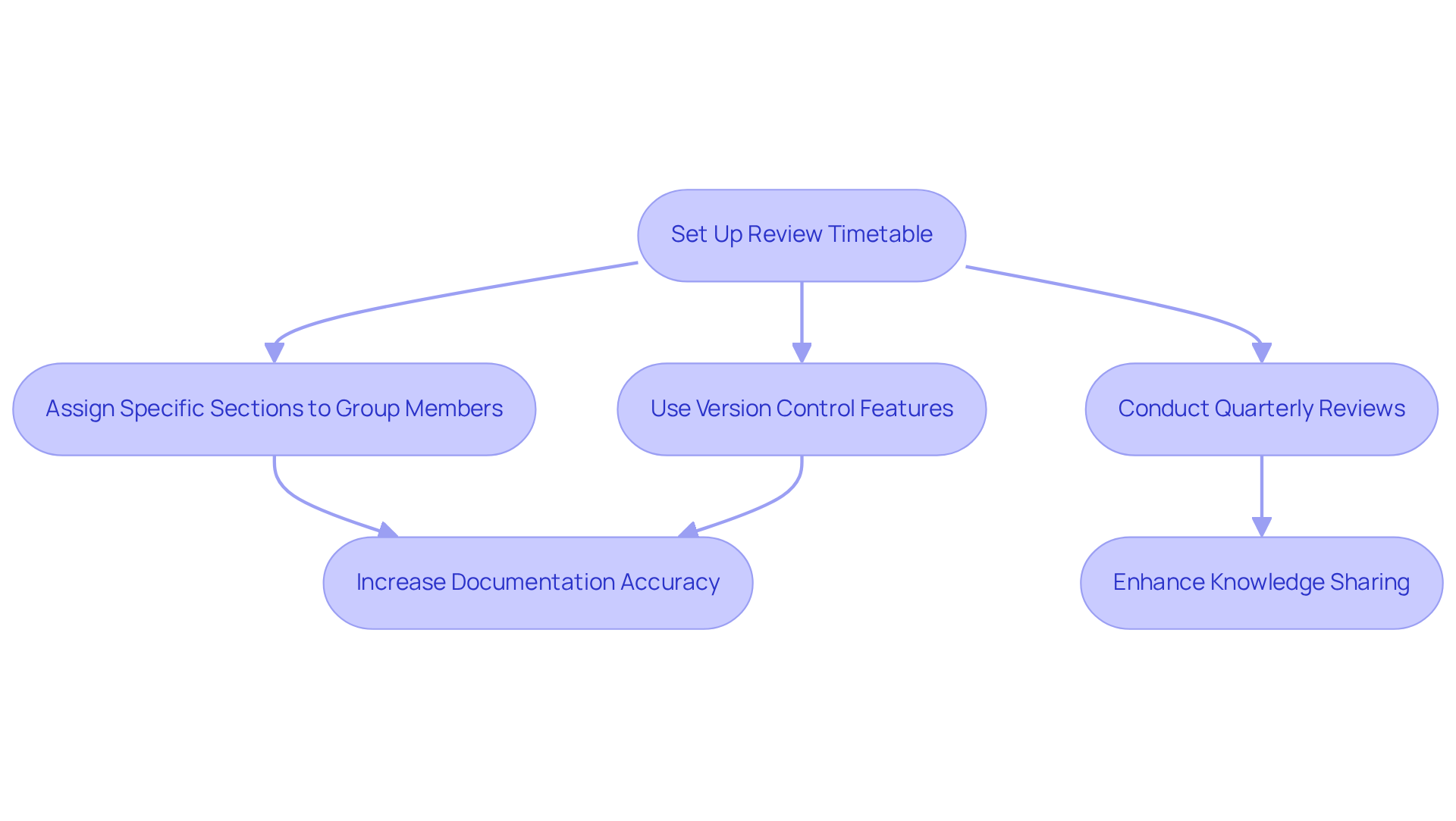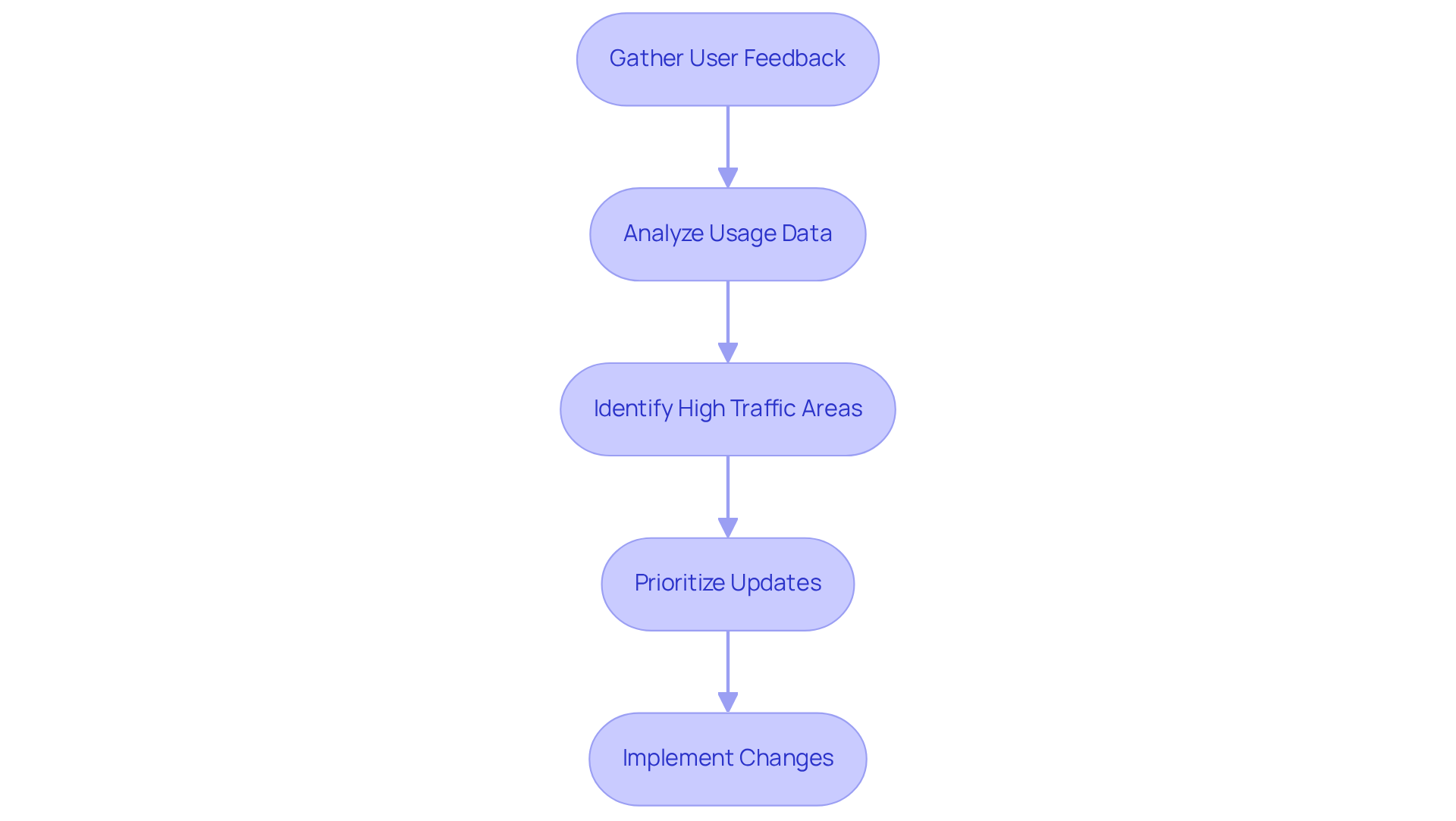
Overview
You might be wondering how to make the most out of a cloud service wiki. Well, this article highlights four best practices that can really make a difference!
- First off, it’s all about having clear objectives. You want to know what you’re aiming for, right?
- Next, think about user-friendly platforms—nobody enjoys a clunky interface.
- Consistent naming conventions are also key; they help everyone stay on the same page.
- Lastly, don’t forget about regular content reviews. Keeping things fresh is crucial!
These practices are backed by some great examples and case studies that show just how effective wikis can be in boosting team collaboration, improving documentation, and creating a culture of continuous improvement within organizations. So, as you dive into these tips, consider how they might help tackle any documentation challenges you face. Let’s explore these ideas together!
Key Highlights:
- Cloud service wikis serve as centralised hubs for team collaboration, enabling real-time content creation and sharing.
- They enhance communication and reduce the need for lengthy meetings, particularly beneficial for remote teams.
- Wikis foster transparency and preserve critical knowledge, aiding in onboarding and operational efficiency.
- Best practises for setting up a wiki include defining clear objectives, choosing user-friendly platforms, and establishing consistent naming conventions.
- Regular content reviews and version control are essential for maintaining the relevance and accuracy of the information.
- User feedback and analytics should be utilised to inform content strategy and improve engagement with the wiki.
- The use of cloud service wikis can significantly enhance documentation practises and knowledge sharing within teams.
Introduction
You might be wondering how the rise of remote work has changed the way teams collaborate. Well, it’s made effective communication more crucial than ever! Enter cloud service wikis—powerful tools that centralize information, streamline workflows, and foster collaboration among dispersed teams. But here’s the catch: implementing these platforms effectively can be a bit tricky.
So, how can organizations ensure that their cloud service wikis not only serve as knowledge repositories but also boost team dynamics and productivity? Let’s dive into that!
Understand the Role of Cloud Service Wikis in Team Collaboration
You might be wondering how a cloud service wiki can truly benefit your team. Well, these platforms are like centralized hubs for information, allowing groups to collaborate effortlessly, no matter where they are in the world. Imagine being able to create, edit, and share content in real-time—this not only boosts communication but also cuts down on those long, drawn-out meetings. For instance, think about a software development team that documents coding standards and project updates within a wiki. This way, everyone stays in the loop and aligned.
This practice fosters a culture of transparency and keeps critical knowledge safe and accessible, which is super helpful for onboarding new employees and ensuring smooth operations. The impact of having a centralized information repository on group communication is huge—it streamlines how information flows and encourages collaboration, especially in remote work settings where effective communication is key to success in 2025.
Speaking of that, Anastasia Masadi, a Product Owner, shares her experience: "SowFlow has been a game changer in the way we document work and deliver to our clients. I do not have to take each screenshot separately, and do not even have to leave the browser while I am creating SOPs and training materials. SowFlow gave me time from my life back." Now, isn't that a relief?
The Bamser case study further highlights the perks of rolling out a new intranet and document management system. It shows just how much centralized information repositories can improve project and client outcomes. This really reinforces the value of utilizing cloud service wikis to enhance team collaboration. So, why not explore how a wiki can transform your team's workflow?

Establish Best Practices for Setting Up Your Cloud Service Wiki
If you're looking to effectively set up your cloud service wiki, you may be wondering where to begin. First things first, define clear objectives that are tailored to your intended use.
- Who's your main audience?
- What types of material do you want to include?
It’s important that everything aligns with your organizational goals.
Now, let’s talk about the platform. Choosing a user-friendly one is crucial! Look for something that encourages collaboration and integrates seamlessly with the tools you already use—like SowFlow. It really simplifies the creation and updating of user guides, making it a breeze to keep your documentation current and relevant.
Next up, implementing a consistent naming convention and categorization system can really enhance navigation and user experience. This structure helps groups find information quickly, cutting down on the time spent searching for resources. Plus, setting clear guidelines for content creation and editing is key to maintaining quality and coherence across the platform.
For instance, imagine a marketing group using an online platform to record campaign strategies. This way, all members can jump in and access the latest insights easily.
By following these best practices, you can create a dynamic and effective cloud service wiki that not only fosters collaboration but also encourages knowledge sharing. So, what are you waiting for? Let’s dive into ensuring the success of your cloud service wiki!

Implement Strategies for Continuous Content Management and Updates
You might be wondering how to maintain the relevance of your cloud service wiki. A great way to do this is by setting up a review timetable that includes regular evaluations of existing pages. Why not assign specific sections to your group members? This way, everyone feels accountable for updates. Plus, using version control features helps you track changes and maintain a history of edits, which is super important for understanding how your content has evolved.
For example, a project management group at a leading tech firm started conducting quarterly reviews of their cloud service wiki. Guess what? They saw a 30% increase in documentation accuracy and group adaptability! This practice not only boosts adaptability but also encourages a culture of ongoing improvement within the team. By prioritizing information management and making the most of SowFlow's tools, your team can really elevate their documentation practices and enhance overall knowledge sharing. So, why not reach out to us to discover how SowFlow can streamline your documentation process?

Leverage User Feedback and Analytics for Ongoing Improvement
You might be wondering how to improve your cloud service wiki even further. Well, a great starting point is to actively gather user feedback through surveys and discussion forums. By examining usage data, you can figure out which pages are getting the most traffic and spot areas that might need a little extra love. For example, the Kindura project showed us that centralized storage services can lead to big cost savings and better management of storage resources. This really highlights the practical benefits of taking a data-driven approach!
So, how can this insight help you? It can inform your content strategy and help you prioritize those all-important updates. If your analytics show that a specific section is frequently accessed but has low engagement, it might be time to think about adding more interactive elements or clearer instructions. By consistently bringing in user feedback, you’re not just improving the wiki’s functionality; you’re also fostering a sense of ownership among your team members, encouraging them to jump in and contribute more.
And let’s not forget about the power of analytics! They can streamline your processes and enhance knowledge management, which is exactly what operations managers are looking for to boost their teams’ efficiency. So, why not take these steps and see how they can transform your wiki into a more engaging and effective resource?

Conclusion
You might be wondering how a cloud service wiki can really make a difference for your team. Well, implementing one can significantly enhance collaboration and streamline information management. By creating a centralized hub for documentation, your team can improve communication, cut down on those lengthy meetings, and keep everything transparent. The benefits are pretty clear: not only does it boost operational efficiency, but it also nurtures a culture of collaboration that’s essential in today’s remote work landscape.
In this article, we’ve outlined some key practices for setting up and managing a cloud service wiki. From defining clear objectives and picking user-friendly platforms to establishing consistent content management strategies, every step is crucial in crafting an effective resource. Plus, by leveraging user feedback and analytics, you can ensure the wiki stays relevant and engaging for everyone involved.
As organizations adapt to changing work dynamics, embracing the power of cloud service wikis becomes more important than ever. By focusing on best practices in both implementation and ongoing management, your team can unlock its full potential, taking collaboration and knowledge sharing to new heights. So, why not take action? Let’s explore how a well-structured cloud service wiki can transform your workflows and contribute to your overall success.
Frequently Asked Questions
What is a cloud service wiki?
A cloud service wiki is a centralized platform for information that allows teams to collaborate effortlessly, create, edit, and share content in real-time, regardless of their location.
How do cloud service wikis benefit team collaboration?
They boost communication, reduce the need for lengthy meetings, and foster a culture of transparency, keeping critical knowledge safe and accessible for team members.
What role do cloud service wikis play in onboarding new employees?
They provide a centralized repository of information that is helpful for onboarding new employees, ensuring they have access to essential knowledge and resources.
Can you provide an example of how a cloud service wiki is used in a team setting?
A software development team might document coding standards and project updates within a wiki, allowing everyone to stay informed and aligned.
What impact do cloud service wikis have on communication in remote work settings?
They streamline information flow and encourage collaboration, which is crucial for effective communication in remote work environments.
How has SowFlow impacted team documentation according to Anastasia Masadi?
Anastasia Masadi mentioned that SowFlow has transformed how her team documents work, allowing her to create SOPs and training materials without leaving the browser, ultimately saving her time.
What does the Bamser case study reveal about centralized information repositories?
The Bamser case study demonstrates that implementing a new intranet and document management system can significantly improve project and client outcomes, reinforcing the value of using cloud service wikis for team collaboration.
👍
What others are liking
5 Steps to outline your ideal documentation structure
5 MINS READ
Where to start the your journey of mapping out your ideal documentation structure, aligning it with the very heartbeat of your organization?
Defining a winning level of detail in your process
3 MINS READ
What is too much detail, and what is too little? This article described in that winning level detail about what detail is enough.





